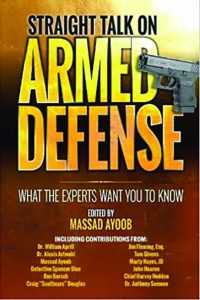Review by Chris Bird
 STRAIGHT TALK ON ARMED DEFENSE: WHAT THE EXPERTS WANT YOU TO KNOW, edited by Massad Ayoob. ©2017. Published by Gun Digest Books, Iola, WI. 256 pages, trade paperback; List Price $21.99. less while available on Amazon or Barnes & Noble.
STRAIGHT TALK ON ARMED DEFENSE: WHAT THE EXPERTS WANT YOU TO KNOW, edited by Massad Ayoob. ©2017. Published by Gun Digest Books, Iola, WI. 256 pages, trade paperback; List Price $21.99. less while available on Amazon or Barnes & Noble.
Massad Ayoob is well-known in the gun community as an author, columnist, firearms instructor and expert witness. In his latest book he has assembled the writings of 11 other experts on particular aspects of armed defense. Each of these experts, including Ayoob, has contributed a chapter.
John Hearne, a federal law-enforcement officer and firearms instructor, writes about the brain and the effects of stress. While a few people perform well under stress, most of us need all the training and mental preparation we can absorb prior to a deadly force encounter.
Anthony Semone, a law-enforcement firearms instructor and also a psychologist, opines mostly on the psychological aftermath of a deadly force incident. He quotes at length from an interview he had with a man who shot and killed a neighbor. The man was charged with First Degree Murder and spent a year in jail awaiting trial. He was acquitted but felt bitter about the trial and had difficulty relating to people afterwards.
Semone points out that a civilian forced to kill in self-defense doesn’t have the support system that police officers benefit from. Summing up, he says: “Private citizens who chose to go armed in the service of the protection of our life and the lives of those we hold close to our heart, well, we do that at our own psychological peril.”
Alexis Artwohl is a behavioral science consultant to law enforcement. She has debriefed hundreds of officers who have survived gunfights. Quoting various scientific experts, she says our memories of a high-stress event will be incomplete and inaccurate, more so just after the event. She recommends not giving a detailed statement until the passage of one or two sleep cycles have passed. This is becoming normal practice of officers involved in shooting incidents.
William Aprill is a mental health professional and former law-enforcement officer. He describes the type of people we are likely to encounter when using deadly force in self-defense.
Craig Douglas is a retired police officer and SWAT team commander. He deals with the details of criminal attacks and what you can do about them. Common factors present in most such attacks are: “close range, more than one assailant, and the presence of a weapon.”
Massad Ayoob writes about the armed lifestyle. He discusses the responsibilities of living and traveling while armed. He ends the chapter with 10 Commandments of Concealed Carry.
Tom Givens has a background of 25 years in law-enforcement followed by 18 years with his own range and training facility. He advises people about how to find good training and discusses the shortcomings of instructors with military and law enforcement backgrounds. The roles of soldier and police officer are completely different from that of the armed civilian.
Spencer Blue is the nom de plume of a robbery detective in a major city. He recounts details of nine robberies or attempts, most of which did not go well for the good guy. He points out what the victims could have done differently.
Ron Borsch has a military and law-enforcement training background. His specialty is non-terrorist mass shooting and he keeps a database of about 200 incidents both in the U.S. and abroad. He points out that almost all rapid mass murder incidents occur in so-called “Gun Free zones.” He invented the term “Stopwatch of Death” to compare timelines with numbers of killed and wounded. He lists, with some detail, more than 50 such mass murders.
Harvey Hedden, a veteran of 39 years in law enforcement, provides advice on dealing with police during a traffic stop or after a shooting.
“If an officer observes you with a firearm in your possession, you are not innocent until proven guilty. You are a potential threat. Yes, you should expect courtesy, but safety comes first,” he says.
Attorney Jim Fleming takes us through the legal system from first arraignment, through the trial, to the appeal process. He says in a criminal trial, your odds of winning are never better than 50/50.
Marty Hayes was a law-enforcement officer before starting a private firearms training operation – the Firearms Academy of Seattle – with his wife Gila. A law school graduate, he started the Armed Citizens Legal Defense Network. Hayes analyses the prepaid legal defense schemes versus straight insurance coverage. Hayes poses questions you need to ask before signing up for coverage. Does the organization cover the cost of private investigators and expert witnesses as well as lawyers? Does it have enough money to provide you with an adequate defense considering that a criminal trial will probably exceed $100,000. Are your expenses paid up front?
Ayoob ties things up in a final section in which he discusses where to find the knowledge you need, by taking courses from experts to building a library. He also debunks nine myths of armed self-defense.
Straight Talk on Armed Defense is certainly one of the best books I have ever read on the subject because it contains not just one person’s advice and experience but that of 12 experts in the field. Anyone who carries a gun needs to read it, not just once but perhaps once a year.



